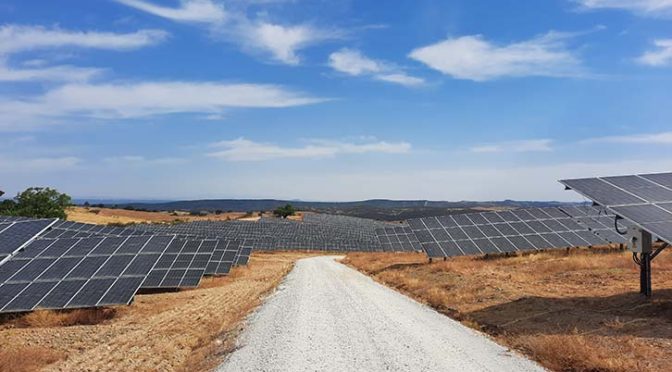Iberdrola has obtained the Environmental Impact Statement (EIS) for the construction of a new 375 MW photovoltaic project in the town of Cedillo in Cáceres. This new plant will have sufficient capacity to supply 178,000 homes with clean energy, more than the population of a city like Badajoz, and will prevent the emission of 77,000 tonnes of CO2 per year.
The installation will have more than 576,000 bifacial photovoltaic modules that allow for higher production, as it has two light-sensitive surfaces. In this way, it will be able to produce more than 582,400 MWh of indigenous green energy per year – an amount that would have required more than 97 million cubic metres of gas to be generated by a combined cycle.
Its construction will also boost the supply chain related to the energy transition with the participation of local suppliers such as Faramax, from Malpartida de Plasencia, which will provide the transformers. The towers of the evacuation power line will be provided by IMEDEXSA, of Casar de Cáceres. The works will also contribute to job creation, with the generation of up to 800 jobs during peak periods. In addition, the environmental studies have been carried out by Ecoenergías del Guadiana, also from Extremadura.
The energy produced by the plant will be evacuated through an encapsulated substation that also serves two other photovoltaic installations with a combined capacity of 100 MW and a hydroelectric plant of almost 500 MW located in the same municipality. This substation has been a major technological and logistic challenge to ensure minimum environmental impact in the surroundings of the Tagus International Natural Park, a protected area between Spain and Portugal. Manufactured in Italy and transported in containers weighing more than 50 tonnes, this infrastructure occupies only 300 m2, compared to the 10,000 m2 of land usually required for equipment of these characteristics.
This project – backed by the Town Council and the Cedillo Agrarian Society – will be located on a communal farm owned by a large number of local residents, who will be able to continue their livestock farming activities in the same area.
The town of Cedillo is an example of the contribution of renewable energies to the sustainable development of rural areas. Iberdrola plans to set up the first solar community in Spain for an entire village in this municipality. Thanks to this initiative, all the inhabitants of this town will enjoy savings of 50% on their electricity bills.
To this end, the company will install small photovoltaic plants with a combined capacity of 340 kW on the roofs of municipal facilities and on land provided by the City Council. Iberdrola will assume the total investment for the assembly and management of this collective self-consumption system, which will be put into operation at the beginning of 2023.
Main promoter of photovoltaic solar energy in Spain
The new photovoltaic plant at Cedillo joins the 12 other photovoltaic projects currently being executed by the company, the main developer of this technology in Spain. The initiatives under construction total 630 MW, half of which are located in Extremadura, where Iberdrola is building the Almaraz I and II plants (80 MW), which will be connected to the grid this year, and the Tagus complex in Alcántara, comprising four plants with a total capacity of 200 MW.
The company is also executing eight other facilities in Castilla y León, Castilla-La Mancha and Andalusia using this technology, totalling 271 MW. These are the Villarino (50 MW) plant in Salamanca; Valbuena (50 MW) and Manantiales (30 MW) in Guadalajara; the Guillena project (144 MW) in Seville; Cespedera (27 MW) in Cadiz; and Virgen de Aremos III (50 MW) in Palencia.
In addition, Iberdrola plans to start construction this year on another six projects that will provide 793 new MW of solar power in four autonomous communities: Ciudad Rodrigo (318 MW) in Salamanca; Fuentes (50 MW), Peñarrubia (50 MW) in Murcia; and the aforementioned Cedillo, in Cáceres.
Among the projects commissioned so far this year is the Francisco Pizarro project which, with 590 MW of power, is the largest photovoltaic plant in Europe and the Iberdrola group’s largest plant of this type in the world. Made up of 1.5 million photovoltaic modules, it will generate enough clean energy to supply more than 334,000 homes and prevent the emission of 140,000 tonnes of CO2 into the atmosphere per year.
10,000 new MW in Spain by 2030
Extremadura is one of Europe’s richest regions in terms of natural resources and a key location for the development of solar energy. The region has become the spearhead of Iberdrola’s commitment to boosting renewables in Spain. The company’s investment plan foresees the installation of 10,000 new MW in the country by 2030, a development in which the Extremadura region is playing a key role.
In the 2020-2025 period alone, Iberdrola will have installed more than 2,800 MW of renewable energy in Extremadura, with an investment of more than 1,700 million euros and the creation of some 7,400 jobs over the five-year period.
The Iberdrola group began its commitment to renewable energies more than two decades ago as a fundamental pillar on which to build its clean, reliable and intelligent business model. Thanks to this vision, the company is today a world leader in renewable energies, with 38,000 MW of renewable capacity installed worldwide – 19,370 MW in Spain – at the end of the first half of 2022, and is a leader in the energy transition towards a low-emission economy.


